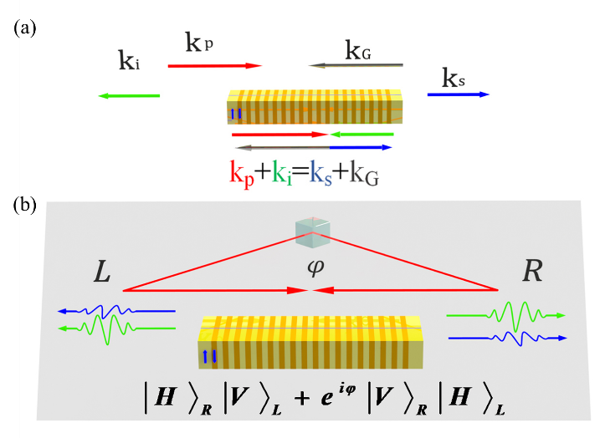Narrowband photonic entanglement is a crucial resource for long-distance quantum communication and quantum information processing, including quantum memories. However, the entangled photon source needs to be compatible with information processing devices in practical applications, where the photon-electron interaction is normally required. The bandwidth of such photon-electron interaction is fundamentally limited by the energy level of the electrons and often in the order of a hundred megahertz.
The recent breakthrough in the solid-state quantum memories has pushed this bandwidth limit to the order of Giga-hertz, though such bandwidth is still too narrow for the conventional entangled photon sources based on spontaneous parametric down-conversion (SPDC).
Much effort has been devoted to shrink the biphoton bandwidth, such as the passive filtering or the cavity enhancement. But it either reduces the source brightness, or adds complexity and instability of the system.
On the other hand, the counterpropagating phase-matching geometry can inherently reduce the phase-matching bandwidth without cavity interactions. In such configuration, signal and idler photons generated from SPDC propagate in opposite directions, possessing a bandwidth two orders of magnitude narrower than that of the conventional SPDC and thus showing prospect for matching solid-state quantum memory devices.
The research group led by Profs. Z. Xie and Y.-X. Gong from Nanjing University researched the first experimental generation of narrowband photonic polarization entanglement with counterpropagating domain engineering. The research results are published in Photonics Research, Volume 9, No. 10, 2021 (Yi-Chen Liu, Dong-Jie Guo, Ran Yang, Chang-Wei Sun, Jia-Chen Duan, Yan-Xiao Gong, Zhenda Xie, Shi-Ning Zhu. Narrowband photonic quantum entanglement with counterpropagating domain engineering[J]. Photonics Research, 2021, 9(10): 10001998).
The narrowband polarization-entangled photon source is based on the state-of-art counterpropagating domain-engineering in a periodically-poled KTP waveguide. Due to the counterpropagating phase-matching, the source reached a bandwidth of 7.1 GHz, which is also confirmed by Hong-Ou-Mandel interference with 155-ps base-to-base dip width and (97.1±0.59)% high visibility.
Compared with the conventional SPDC process, a natural separation of the parametric light can be achieved in the counterpropagating SPDC process, as shown in the Figure. With the bidirectional pump at frequency degeneracy, two type-II counterpropagating SPDC processes can happen with reversed directions, thus resulting in the generation of the polarization-entangled state  .
.

Scheme of the counterpropagating polarization-entangled photon source. (a) Phase-matching diagram of the counterpropagating SPDC; (b) polarization entanglement generation from the counterpropagating SPDC with bidirectional pump light.
The entanglement is measured to violate the Clauser–Horne–Shimony–Holt (CHSH)-type Bell inequality by up to 18.5 standard deviations, with an S value of 2.720 ± 0.039. The entangled state is further characterized by quantum state tomography showing a fidelity of F = (95.71 ± 0.61)%. These unique features broadened the research for preparation of the photonic entanglement sources and warranted broad practical quantum information applications.
This work demonstrates the first narrowband polarization-entangled photon source based on the counterpropagating phase matching. The 7.1 GHz bandwidth is two orders of magnitude narrower than the conventional SPDC, which may match well with solid-state quantum memory devices. This work demonstrates the unique spectral properties and the merits of the counterpropagating phase matching.
Prof. Shi-Ning Zhu, the head of the research group, said that, in future work, the counterpropagating domain engineering could also be adopted into the fast-developing thin-film lithium liobate platform, and the tight mode confinement can further boost the conversion efficiency in a much smaller footprint for large-scale integration.
Therefore, it is a unique and powerful tool for narrowband photonic quantum entanglement generation, which may find applications in quantum information technologies requiring photon–electron interaction, including quantum memory.


